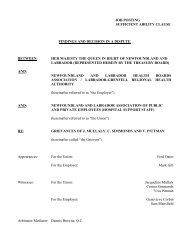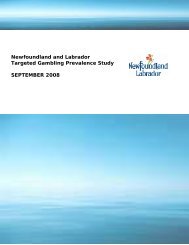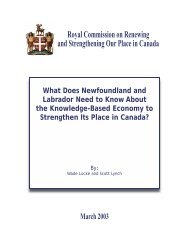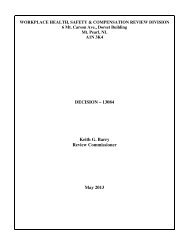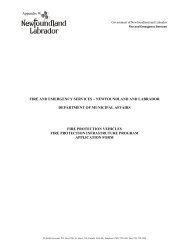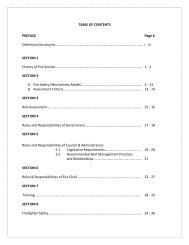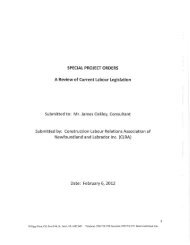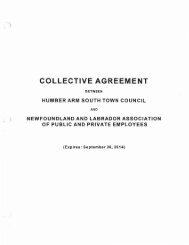Energy Plan - Government of Newfoundland and Labrador
Energy Plan - Government of Newfoundland and Labrador
Energy Plan - Government of Newfoundland and Labrador
You also want an ePaper? Increase the reach of your titles
YUMPU automatically turns print PDFs into web optimized ePapers that Google loves.
POLICY<br />
ACTIONS<br />
Air Emissions<br />
The <strong>Government</strong> <strong>of</strong><br />
<strong>Newfoundl<strong>and</strong></strong> <strong>and</strong> <strong>Labrador</strong> will:<br />
• By 2015, target the<br />
elimination <strong>of</strong> 1.3 million<br />
tonnes <strong>of</strong> GHG emissions<br />
per year, as well as all other<br />
pollutants from Holyrood,<br />
by building Lower Churchill<br />
<strong>and</strong> the <strong>Labrador</strong>-Isl<strong>and</strong><br />
Transmission link. This will<br />
ensure more than 98 per<br />
cent <strong>of</strong> electricity generated<br />
for our own use comes from<br />
renewable sources.<br />
• Join the Climate Change<br />
Registry to ensure consistent<br />
<strong>and</strong> verifiable measurement<br />
<strong>of</strong> GHG emissions as per<br />
the commitments from the<br />
August 2007 Meeting <strong>of</strong> the<br />
Council <strong>of</strong> the Federation.<br />
• Release an updated Climate<br />
Change Action <strong>Plan</strong> by 2008<br />
incorporating specific targets<br />
<strong>and</strong> commitments which<br />
build upon initiatives being<br />
undertaken by the province<br />
through the Council <strong>of</strong> the<br />
Federation <strong>and</strong> the New<br />
Engl<strong>and</strong> Governors <strong>and</strong><br />
Eastern Canadian Premiers.<br />
• Work with industry <strong>and</strong> other<br />
stakeholders to develop a<br />
GHG strategy for the energy<br />
sector.<br />
(continued)<br />
While these factors present challenges, there are opportunities for improvement.<br />
We can advance the development <strong>and</strong> use <strong>of</strong> more clean, renewable sources <strong>of</strong><br />
electricity to reduce our future dependence on fossil fuel. We can also make a<br />
major contribution to the environment beyond our borders through our capacity<br />
<strong>and</strong> potential to develop <strong>and</strong> deliver renewable electric energy to other North<br />
American markets after our own needs are met.<br />
The Lower Churchill project alone has a combined capacity <strong>of</strong> over 2,800 MW<br />
<strong>of</strong> clean energy <strong>and</strong> has the potential to reduce GHG emissions by nearly 13<br />
million tonnes every year if it displaces or avoids oil-fired generation like that<br />
at Holyrood or up to 16 million tonnes if it displaces coal generation. This<br />
provides the opportunity to displace approximately 11.8 million tonnes <strong>of</strong> GHG<br />
emissions beyond the 1.3 million tonnes generated by the Holyrood thermal<br />
plant. Likewise, development <strong>of</strong> our wind resources, both on the Isl<strong>and</strong> <strong>and</strong> in<br />
<strong>Labrador</strong>, can also generate thous<strong>and</strong>s <strong>of</strong> Megawatts <strong>of</strong> additional capacity. By<br />
linking the <strong>Labrador</strong> <strong>and</strong> <strong>Newfoundl<strong>and</strong></strong> transmission systems, we will be able to<br />
supply more than 98 per cent <strong>of</strong> the electricity used in the province from clean,<br />
renewable sources compared to approximately 85 per cent today.<br />
<strong>Newfoundl<strong>and</strong></strong> <strong>and</strong> <strong>Labrador</strong> also has an opportunity to utilize additional sources<br />
<strong>of</strong> energy that produce lower levels <strong>of</strong> GHGs <strong>and</strong> other air pollutants than<br />
emissions resulting from oil-fired generation. These include natural gas <strong>and</strong><br />
renewable energy sources such as smaller hydro, wind <strong>and</strong> tidal.<br />
A significant growth area for GHG emissions in the province in recent years has<br />
been <strong>of</strong>fshore oil production. Some emissions are inevitable, for example from<br />
use <strong>of</strong> produced gas as fuel on the platforms <strong>and</strong> diesel fuel for supply ships.<br />
Also, when production is starting or restarting, some flaring has to be allowed.<br />
A limited amount <strong>of</strong> ongoing flaring <strong>of</strong> mixed gases is also allowed, within limits<br />
imposed by the C-NLOPB. The C-NLOPB has recently endorsed the World Bank’s<br />
Voluntary St<strong>and</strong>ard for Global Gas Venting <strong>and</strong> Flaring Reduction, committing it to<br />
ensuring best practices are followed to reduce flaring to the absolute minimum.<br />
Reduced flaring conserves an important resource <strong>and</strong> reduces GHG emissions.<br />
L<strong>and</strong>fills are also a significant source <strong>of</strong> air emissions as they emit GHGs in<br />
the form <strong>of</strong> methane. To reduce the province’s GHG emissions, the Provincial<br />
<strong>Government</strong> will use a portion <strong>of</strong> its <strong>Newfoundl<strong>and</strong></strong> <strong>and</strong> <strong>Labrador</strong> Green Fund to<br />
help assess the feasibility <strong>of</strong> a l<strong>and</strong>fill methane capture <strong>and</strong> recovery facility at<br />
the Robin Hood Bay L<strong>and</strong>fill.<br />
These initiatives will help the province continue with collaborative efforts with<br />
provinces <strong>and</strong> U.S. states under the 2001 New Engl<strong>and</strong> Governors <strong>and</strong> Eastern<br />
Canadian Premiers (NEG-ECP) Climate Change Action <strong>Plan</strong>. The NEG-ECP <strong>Plan</strong><br />
called for a short-term reduction <strong>of</strong> regional GHG emissions to 1990 emissions<br />
by 2010; a mid-term reduction <strong>of</strong> regional GHG emissions by at least 10 per<br />
cent below 1990 emissions by 2020; <strong>and</strong>, a long-term reduction <strong>of</strong> regional GHG<br />
emissions sufficiently to eliminate any dangerous threat to the climate.<br />
52



